Heavy machine gun NSV NSVT 12.7 "Rock"
Machine gun NSV-12,7 "Cliff" (Index GRAU - 6П11) - a machine gun designed to combat lightly armored ground targets (armored personnel carriers), firing points and targets behind small shelters, at a distance of 1000 m, as well as for firing at sea. infantry and vehicles at a distance of up to 1500 m and low-flying aerial targets at a height of up to 1500 m.
History
Heavy machine gun NSV-12,7 "Rock" was developed in the Tula TsKIB SOO at the end of 1960-x - the beginning of 1970-x as a replacement for the obsolete and heavy DShK (DShKM). It got its name after the initial letters of the authors' last names - G. I. Nikitin, Yu. M. Sokolov and V. I. Volkov. Shortly before this, the same team participated in the competition for a single 7,62 mm caliber machine gun, but preference was given to the sample of M. Kalashnikov.
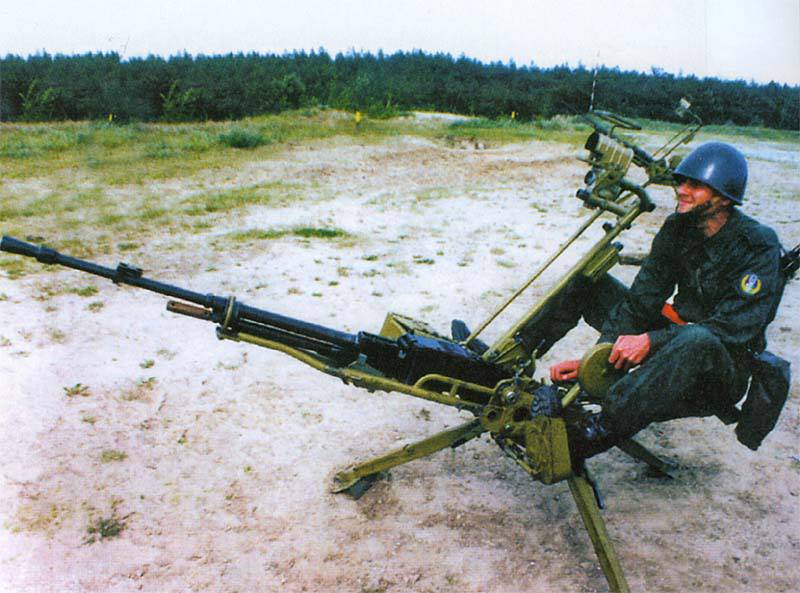
For the production of NSV, it was decided to create a new plant in the city of Uralsk, called Metallist, since the production at the Degtyarev plant in Kovrov was overloaded. A large number of engineers and workers from Tula, Kovrov, Izhevsk, Samara, Vyatskiye Polyan were recruited as labor. In the production of NSV, completely new and original technologies were used by various Allied research institutes, some of which in the manufacture of small weapons not used anywhere else. So, to obtain rifling of the bore, electrochemical treatment was applied, for thermal tempering - a vacuum tempering system, the so-called “thick” chrome plating to increase the survivability of the barrel was achieved by jet chrome plating technology.
In the process of debugging production and regular testing by factory designers, a huge number of changes were made to the design of the machine gun, mainly aimed at improving the survivability and reliability of work, as well as simplifying the design.
In addition to the USSR, NSW was produced at factories in Poland, Bulgaria, and India. Production was transferred to these countries along with a production license tanks T-72, in the armament of which he was a member. In addition to these countries, Iran also received a license, but there is no reliable information about whether the Iranians managed to master the production of the "Cliff".
Ammunition
As ammunition in NSV are used cartridges of standard 12,7x108, including cartridges with bullets B-32, BZT-44, MDZ and BS.
The cartridge B-32 (48 g bullet weight) - armor-piercing incendiary - and BZT-44 (44 g bullet weight) - armored piercing-incendiary-tracer - remained in the "legacy" of the DShK. The most common types. There are two types of them - the so-called "military" (preserved from the Great Patriotic War) and the "new". The fact is that in order to reduce the mass of the machine gun, its trunk was noticeably lightened compared to the DShK. Designers abandoned the use of radiators - in addition to reducing weight, the barrel has become much more technological. But this, in turn, affected its survivability - the first batch of barrels “burned out” after 3-4 thousands of shots. In the infantry version of the machine gun had to complete 3 trunks to comply with the guaranteed life of the entire machine gun - 10 thousands of shots. As a result, it was decided to use the so-called phlegmatizing additives in the production of cartridges. Until this time, they were used only in artillery. Barrel survivability when using new rounds has grown to acceptable limits - on periodic trials, with hard shooting mode - 50 shots with one burst and 50 - with three bursts of 15-20 shots, - the barrel has withstood about 6 thousands of shots. But often the troops did not make a distinction between old and new cartridges, and the Uralsk plant received complaints about the premature “death” of the barrels.
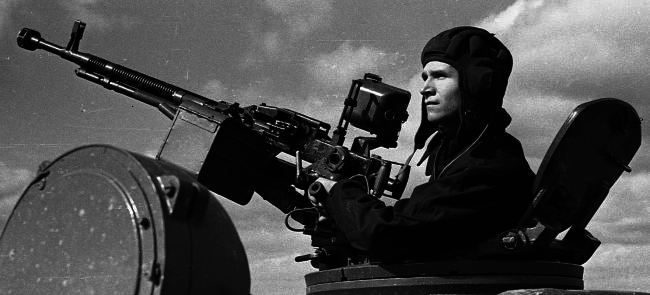
Cartridges MDZ and BS - later.
The MDZ bullet cartridge (43 g bullet weight) - incendiary instantaneous action - was intended to combat low-flying air targets and automotive vehicles.
The BS bullet cartridge (55 d bullet weight) - also armor-piercing and incendiary, but equipped with a refractory heavy core - was designed when it became clear that the B-32 armor penetration was not enough to fight modern BTR and BMP.
Due to the greater prevalence in the world of the cartridge 12,7х99 compared to the Soviet 12,7х108, after the collapse of the USSR in Poland and Uralsk, they tried to master the production of PAC under the patron of NATO. There is no reliable information about the Polish machine gun, but the Urals shortened cartridges shot quite reliably. The fundamental difference that was impossible to overcome was in the design of the tape. From the Soviet tape, the cartridge is fed by pushing the bolt forward, while the cartridge has already been pulled off by the stripper. From NATO automatics pulls back during the shutter. The NSV uses 10-link units that are assembled into 50 tape (in infantry performance) and 70 cartridges (on tank installations). The equipment of the tape is calculated using a special machine. NATO ammunition arrives to the troops already equipped with ribbons of loose elements. Recharging cartridges from one tape to another would have previously, which would have a negative impact on combat work. Therefore, no success was heard about the successful sales and replacement of the heavy Browning М2 on the NWS, the programs of “re-equipment” of the NID were stopped.
Design features
NSV-12,7 was much lighter than its predecessor - 25 kg for a machine gun of this caliber with existing technology is still the limit.
The NSV automatics is based on the discharge of powder gases, the barrel locking is wedge, when the bolt is locked, the bolt moves to the left, while the bolt earring hits the striker.
The trigger mechanism is assembled in a separate box, has a very simple design and allows only automatic firing. In this case, the trigger is not designed to control the fire directly on the machine gun, you must have a handle and trigger or electrostatus on the machine or installations. There is also no reloading handle, and the spring charging force is so high that different lever or block designs are required to reduce it. Original elements were used in the design, all moving parts were equipped with rollers to reduce friction, the cadmium coating served as an additional “lubricant”, the quick-release wedge closing device ensured easy replacement of the barrel without performing adjustment operations after the shift.
The bolt with the bolt carrier and the bolt frame itself are connected to the vapor-discharge piston pivotally. The spring is provided with a buffer. Feed cartridges with metal tape could be left or right. Coupled with the release of spent cartridges forward, and not to the side, this made it easy to combine the “right” - “left” machine guns in twin installations. One of these, in particular, produced Tula Machine-Building Plant. Ryabikov for weapons boats.
The mechanical sight includes an aiming bar marked up for firing up to 2000 m (the aiming bar of the AAC was marked up to 4000 m) and a front sight. The fly was originally folding, but then the factory designers convinced GRAU that there was not much point in this.
Power machine gun - from link metal tape with an open link type "crab". The tape is detachable, consists of individual pieces of 10 links. T-shaped extensions at the ends of the side hooks of the links prevent the latter from disengaging within one piece. The extreme link with the free hook of the T-shaped extension does not have, which allows you to connect individual pieces into a tape of the desired length. The white distinctive strip is painted on the outside of the longitudinal edge of the connecting link. This mark makes it easy to see in the fitted tape that the cartridge is removed from which link it will separate the tape in a given place. Capacity curb tape is determined by the capacity of the cartridge box. For the infantry version - it is 50 ammunition, for tank - 150 ammunition.
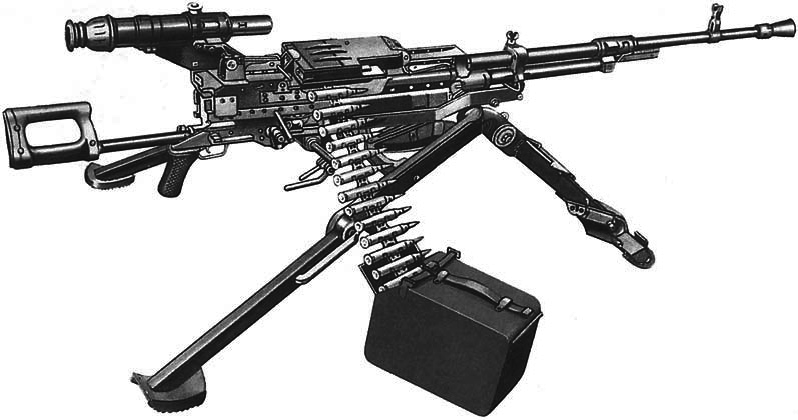
The cartridge in the link is fixed from the longitudinal movement of the stop bottom of the liner in the link limb and the special ridges of the shank, which go into the groove of the liner. Removing the cartridge from the tape in the machine gun (remove the link from the cartridge) occurs in the transverse direction.
The NSV machine gun can also use DShKM tape, which has a practically similar device, but differs in details (two hooks and a T-shaped axis instead of one hook and a notch with a lintel, a bend extending into a groove instead of a bend-stop and crests).
The barrel of the machine gun is quick-detachable, the handle is installed on it. The muzzle of the trunk is equipped with a conical flame arrester.
In the infantry variant, the NSV-12,7 machine gun is used on a tripod machine designed by K.A. Baryshev - L.V.Stepanov. Machine Index - 6Т7. The machine provides firing from different positions and good adaptability to the position, including with different soils, due to the presence on the legs of the machine tool folding coulter (for soft and medium soils) and folding canines (for hard soils). The machine is equipped with a spring-loaded shoulder rest with a through-cut for the hand and a trigger with a pistol grip for fire control, trigger and trigger guard. With the machine gun mounted on the machine, the shoulder rest and the machine trigger are a continuation of the machine gun, while the machine trigger mechanism with its pusher acts on the machine gun trigger itself.
Unlike Kolesnikov’s machine gun for the DShK machine gun, the design of the Baryshev – Stepanov machine gun for the NSV machine gun does not provide for the possibility of anti-aircraft fire. Due to this, the weight of the machine in comparison with the Kolesnikov machine is reduced almost 6 times and is 18 kg. For firing at air targets, a special single installation is used for the NSV machine gun. The installation index is 6У6. It is equipped with a collimator anti-aircraft sight and a separate ground sight. Installation weight without machine gun - 55 kg, with a machine gun and ammunition - 92,5 kg. Machine gun ammunition on an anti-aircraft gun - 70 ammunition.
The NSV machine gun on the 6Т7 infantry machine is serviced, as well as easel machine guns of normal caliber, with two people: the gunner and the gunner’s assistant. For transportation, the machine gun is removed from the machine, and the machine folds up in a compact manner and can be carried on the shoulder straps behind the back of the calculation number.
For armament with NSV-12,7 DOS guns (long-term fire installations - the same as the former DOTs - long-term firing points), the 6Х10 and 6Х11 installations are used. The machine gun on such an installation is fixed in the embrasure of the DOS along with the standard 6Т7 machine: the machine gun is not removed from the machine, but the legs of the machine are folded back. This allows, if necessary, to maneuver the machine gun to be used outside the firing structure on the 6Т7 machine.
Modifications
The main application received a modification NSVT (tank, Index GRAU - 6P17) as anti-aircraft on tanks T-72, T-80, T-90 and later versions of T-64, self-propelled artillery installations, as well as various armored vehicles. In the 1990s, NSV machine guns armed with several thousand Panssari-Sisu armored personnel carriers and Sisu NA-110 combat vehicles made in Finland for their own armed forces and for troops from African countries operating under the auspices of the UN.
The tank version of the machine gun was supplied with an electropet - all the differences end there. The electric release was a primitive coil with a rod, assembled in an airtight, dustproof, waterproof housing. Attached to the rear of the receiver, when the current was applied, the rod moved forward and pressed on the trigger bar.
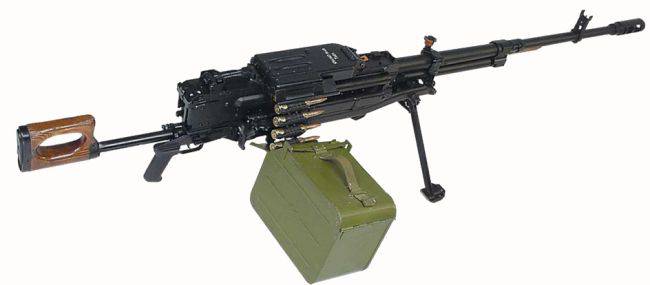
As an infantry machine gun NSV was used on several types of installations. The most successful was the Stepanova-Baryshev 6Т7 machine gun, the machine gun on the machine was called NSVS-12,7 (GRAU Index - 6P16), the 41 kg weighed, the main sight was an optical SPP produced by the Novosibirsk Optical-Mechanical Plant. There was also a series of night sights. The production of the machine and the staffing of the NSCS was carried out at the plant in Vyatskiye Polyany. To extinguish the energy of the machine gun mass was not enough, so the 6Т7 was equipped with an original shock absorber mounted on the sowing front shovel, embedded in the ground. In this case, the mass of the entire machine was added to the mass of the machine gun. The rollback of this design was quite noticeable, which required the installation of a shock absorber, and in the butt, the riflescope “mounted” on the machine gun went along with it, so that the shooter involuntarily blinked when firing. Shooting was officially provided only from a prone position, often in the army they installed a machine gun for shooting from the knee, while he was desperately “goat”, since the shock absorber was placed vertically in this position, there was no need to speak about any shooting accuracy. The 6Т7 firing sector was extremely limited, anti-aircraft firing was impossible.
One of the main advantages of NSV is its versatility, that is, the possibility of its use both for ground and air targets. They tried to use universality, but the installations were terribly bulky, heavy (one of them - 6U6 weighed four times the machine gun itself), did not use popularity among the troops.
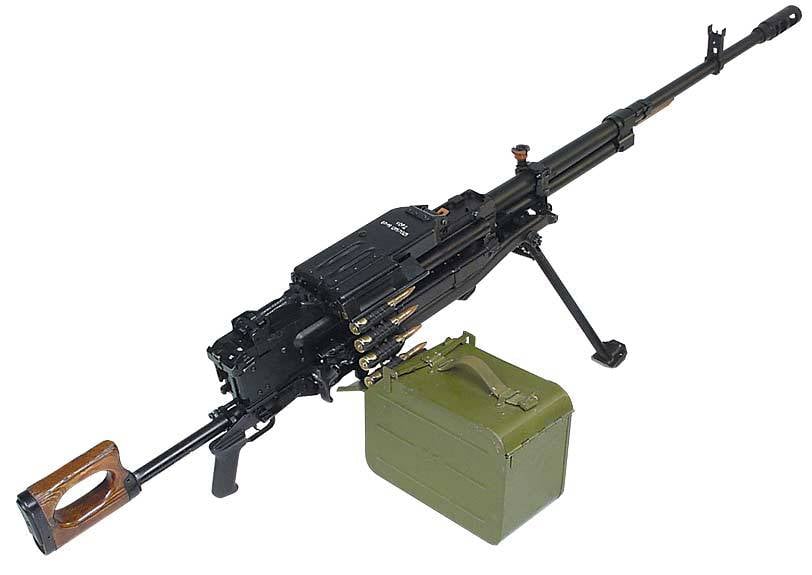
Already in the years of independence of Kazakhstan, several hundred machines were designed and manufactured at the plant in Uralsk, which were an attempt to realize the "universality" of the machine gun. They took as a basis the designs of tank installations, when the machine gun, when firing, moves along the guides of a kind of “bed”. The tripod and bed were separate constructions with a quick-detachable joint, the sight was mounted on a bed, the tripod allowed an installation for shooting lying down and from the knee. There were no devices for fixing the pickup. In general, despite the dampness of the structure, shooting accuracy was not affected, the shooter did not squint his eyes, which allowed him to continuously monitor the shooting results, the impact of kick on the shoulder was much lower than when shooting with 6Т7, the factory arrows showed good accuracy at the ranges of the Ministry of Defense of Kazakhstan , fast transfer of firing both on the front and in depth. The machine gun on the machine received the name NSWP-12,7, the Ministry of Defense of the Republic of Kazakhstan officially adopted it and bought about a hundred pieces.
At the same time, Russia decided to abandon the purchase of machine guns abroad, even in friendly Kazakhstan. At the same time, they didn’t begin production from the original “raw” drawings, at the Degtyarev plant they actually designed a new machine gun, named KORD. Keeping the landing dimensions and ballistics unchanged for interchangeability with existing installations and machines, Kovrovchans drastically changed the scheme of locking the trunk.
Combat application
The new machine gun is designed to deal with lightly armored vehicles and enemy group live targets at a distance of 2000 m, firing points, as well as low-flying air targets at slant ranges to 1500 m. A very powerful 12,7 x108 large caliber cartridge is used, having a whole range of bullets of various purposes: B -32 (armor-piercing incendiary), BZT-44 (armor-piercing incendiary-tracer) and MDZ (incendiary instant action).
The first combat use of NSV was in Afghanistan. At first, on both sides, only modifications of DShK took part in the hostilities (Mujahideen used Chinese-made DShK). But in the second half of the 80-x in the troops appeared and NSV. He was quickly appreciated, his main feature was the ability to conduct aimed fire at the enemy, not allowing him to a distance of effective automatic firing. There are many photos of checkpoints where the 6Т7 machine is loaded with stones, sandbags to prevent its goat jumps. Acquisition of each machine gun with an optical sight, and in the variant of the night one with a night sight, made the calculation of the NWSS with the main "eyes" of the checkpoint.
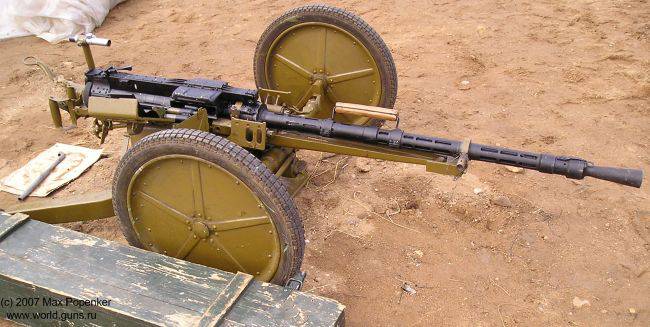
The NSV was no less "beloved" in both Chechen campaigns; among the Chechens, he got the nickname "handsome." There were many curious at first glance "modifications" of the tank "Cliff", which was easier to get to use as an infantry.
The NSV-12,7 is also armed with warships. In particular, there is a twin sea turret-tower installation "Rock-M", consisting of two NSV machine guns, placed in a rotating closed turret. The right machine gun has the right feed tape.
Performance characteristics:
Cartridge - mm 12,7X108
Machine gun weight without ribbon, kg - 25
Barrel weight, kg - 9
Weight of loaded tape with 50 cartridge capacity, kg - 7,7
Weight of cartridge box equipped with 50 cartridges, kg - 11,1
Weight of cartridge, g - 123 — 137
The length of the machine gun, mm - 1560
The length of the machine gun with electrospusk, mm - 1610
The length of the machine gun on the machine 6Т7, mm - 1900
The height of the machine gun on the machine 6T7, mm - 380
Number of grooves - 8
Initial bullet speed, m / s - 845
Muzzle energy of a bullet, J - 15815-17672
Fire Modes - Continuous
Rate of fire (technical rate), v / min - 700 — 800
Fighting rate, in / min - 80-100
Sighting range, m - 2000
Direct shot range at targets with height 2 m, m - 850
The thickness of the pierced armor at a distance of 500 m, mm - 16
Capacity of a tape, cartridges:
- infantry option - 50
- tank version - 150
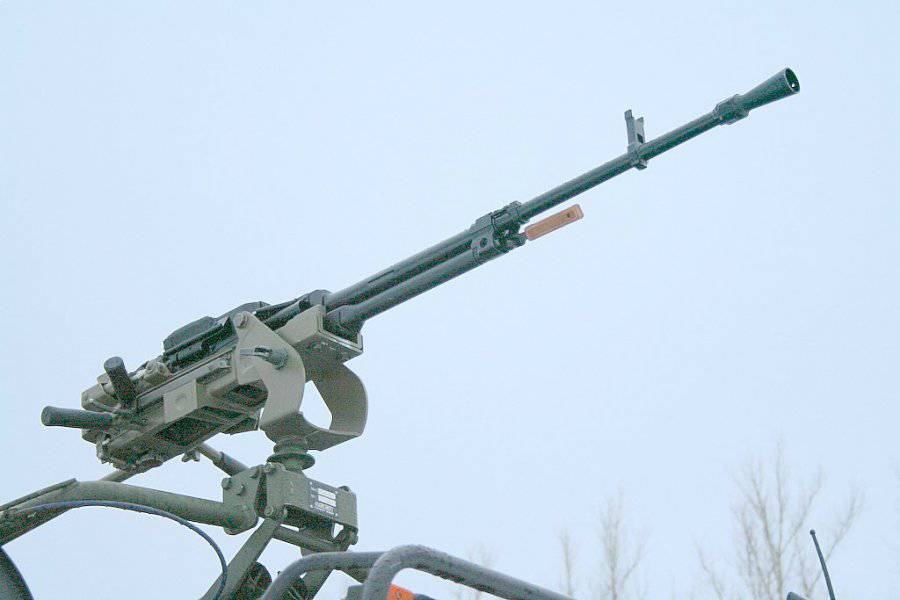
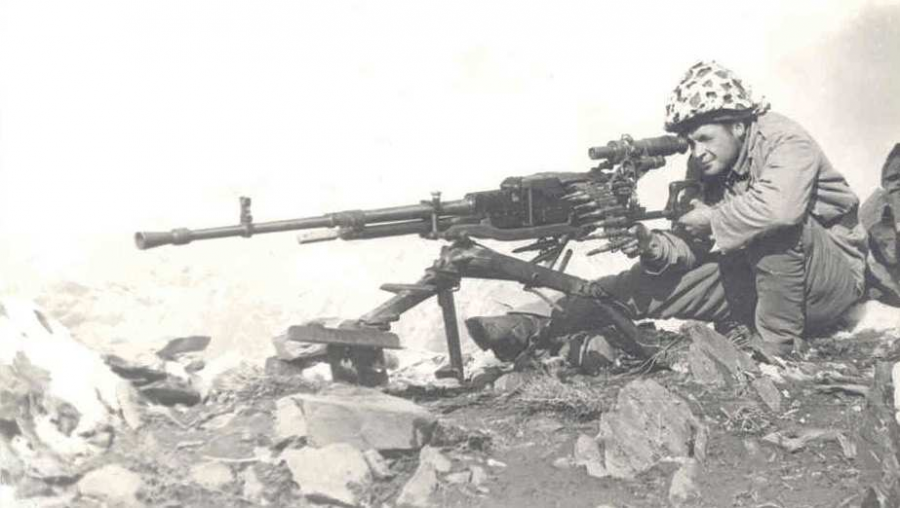
Information